spare tire BUICK ROADMASTER 1993 Owners Manual
[x] Cancel search | Manufacturer: BUICK, Model Year: 1993, Model line: ROADMASTER, Model: BUICK ROADMASTER 1993Pages: 340, PDF Size: 18.34 MB
Page 123 of 340
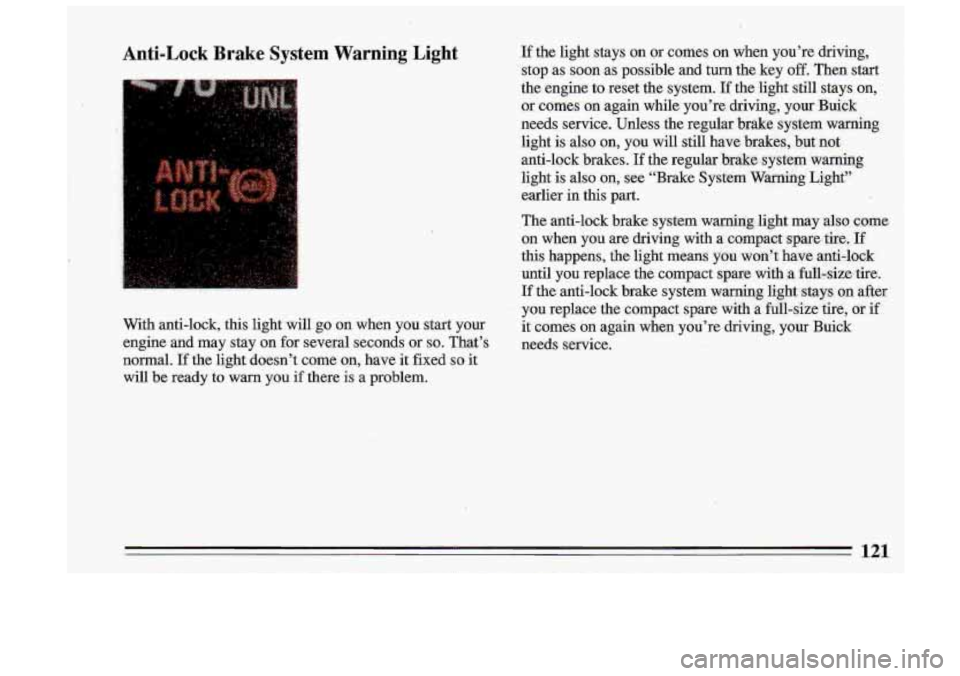
iI
Anti-Lock Brake System Warning Light
. -, i’
.. I. ,:,:
With anti-lock, this light will go on when you start your
engine and may stay on for several seconds or
so. That’s
normal.
If the light doesn’t come on, have it fixed so it
will be ready to warn you if there is a problem.
If the light stays on or comes on when you’re driving,
stop as soon as possible and turn the key
off. Then start
the engine to reset the system.
If the light still stays on,
or comes on again while you’re driving, your Buiek
needs service. Unless the regular ‘brake system warning
light is also
on, you will still have brakes, but not
anti-lock brakes.
If the regular brake system warning
light is also
on, see “Brake System Warning Light”
earlier
in this part.
The anti-lock brake system warning .light may also come
on when you are driving with
a compact spare. tire, If
this happens, the light means you won’t have anti-lo,ck
until you replace the compact spare ,with
.a fuU-simtire.
If the anti-lock brake system warning light stays
on after
you replace the compact spare with a full-size tire, or if
it comes
on again when you’re driving, your Buick
needs service.
121
Page 205 of 340
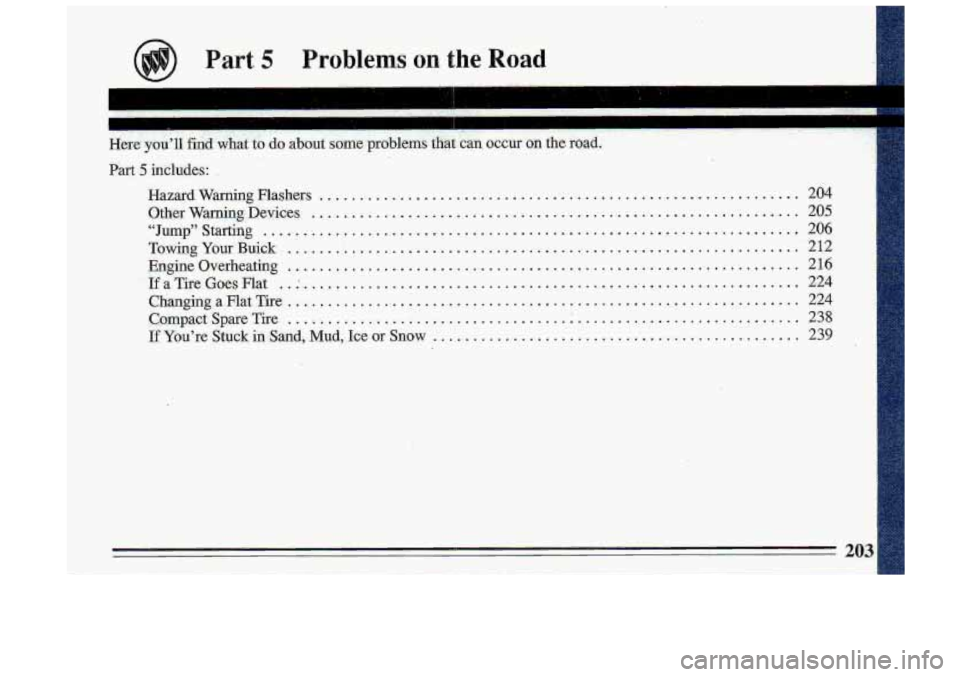
Part 5 Problems on the Road
I- .. . 1. ’ . ’ ‘I
.. .....
Here you’ll find what to do about some problems that can occur on the road .
Part 5 includes:
Hazard Warning Flashers
............................................................
“Jump”Starting ...................................................................
OtherWarningDevices .............................................................
TowingYourBuick ................................................................
Engineoverheating ................................................................
IfaTireGoesFlat .................................................................
ChangingaFlatTire ................................................................
CompactSpareTire ................................................................
If You’re Stuck in Sand, Mud, Ice or Snow ..............................................
204
205
206
212
216
224
224
238
239
Page 229 of 340
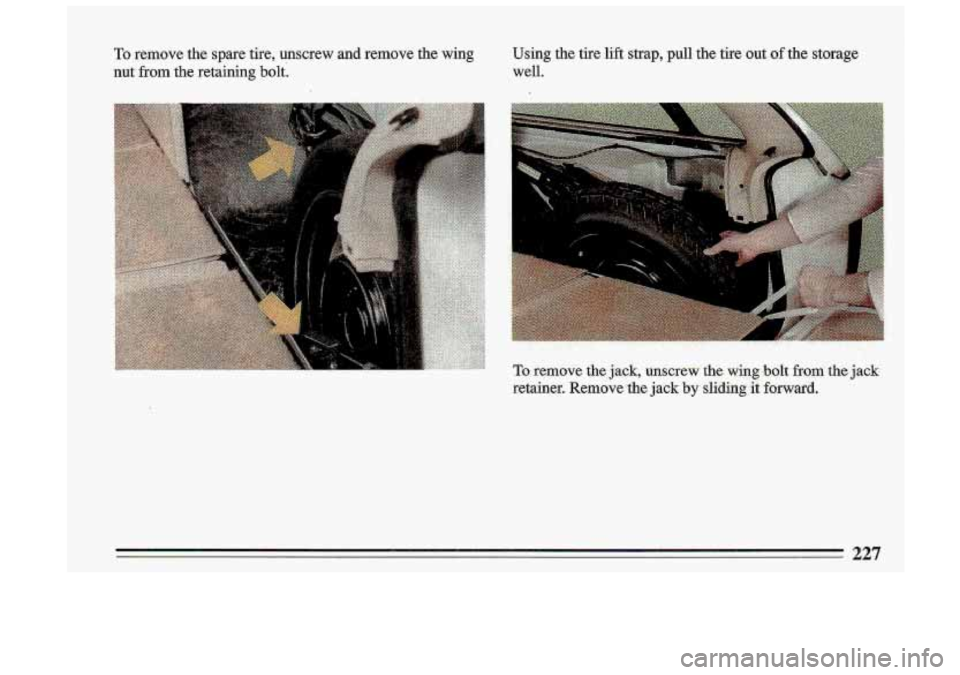
To remove the spare tire, unscrew and remove the wing
nut from the retaining bolt. Using
the tire lift
strap, pull the tire out of the storage
well.
To remove the jack, unscrew the wing -bolt from the jack
retainer. Remove the jack by sliding it forward.
227
Page 237 of 340
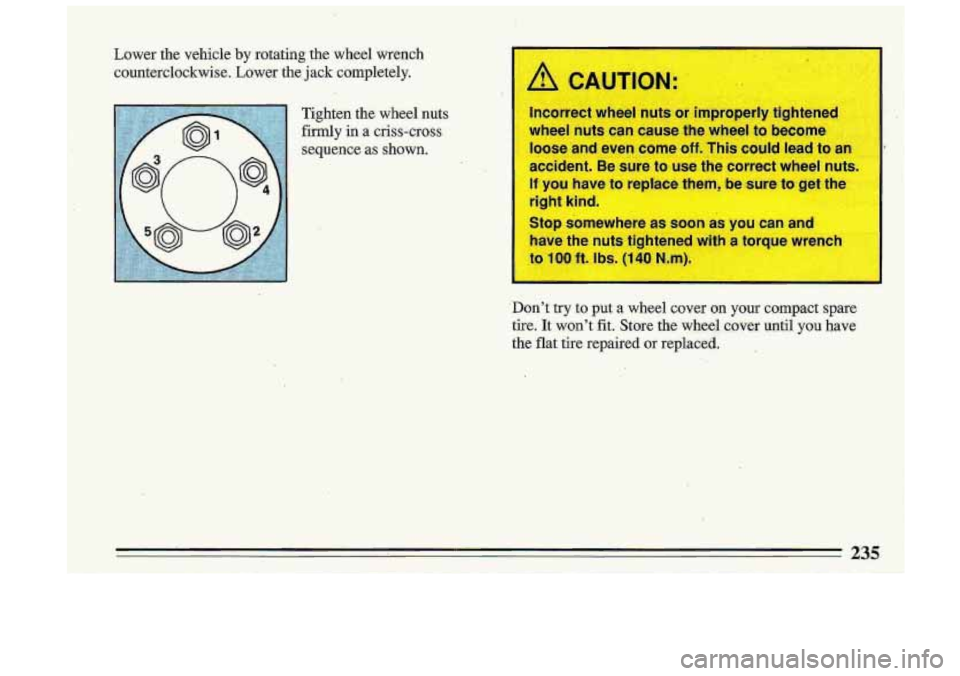
t
Lower the vehicle by rotating the wheel wrench
counterclockwise. Lower the jack completely.
Tighten the wheel nuts
firmly in a criss-cross
sequence as shown.
lncorrect wheel nuts or improperly tightened
wheel nuts can cause the wheel to become
loose and even come
off. This could lead to an
accident. Be sure to use the correct wheel nuts.
If you have to replace them, be sure to get the
right kind.
Stop somewhere
as soon as you can an
have the nuts tightened with
a
to I00 ft. Ibs. (1 40 N.m)
Don't try to put a wheel cover on your compact spare
tire. It won't fit. Store the wheel cover until
you have
the flat tire repaired or replaced.
. .. .i ,?. 1 C.".
235
Page 240 of 340
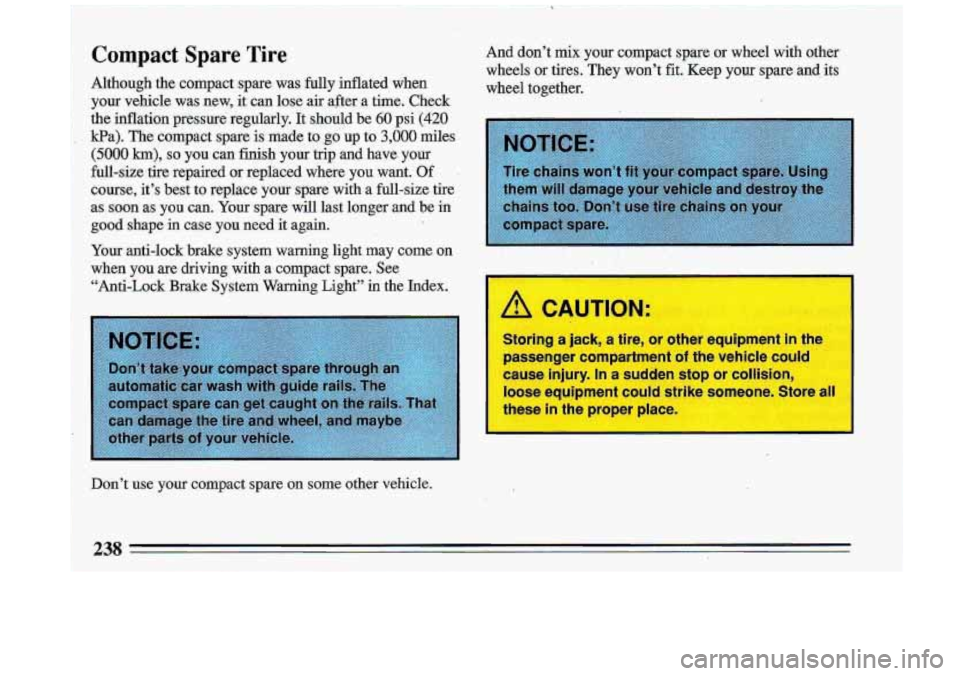
Compact Spare T,ire
Although the compact spare was fully inflated when
your vehicle -was new, it can lose air after a time. Check
the inflation pressure regularly. It should be
60 psi (420
Pa). The compact spare is made to g6 up to 3,000 miles
(50,OO km), so you can finish your trip and have. your
full-size tire repaired
or replaced where you want. Of
course, it’s best to replace your spare with a full-size ti\
re
as soon as you can. Your spare will last longer and be in
good shape in case you need it again.
Your anti-1ock.brake system warning light -may come on
when you are driving with a compact spare. See
“Anti-Lock Brake System Waming Light”
in the Index.
Don’t-use
your compact spare on some other vehicle. And don’t mix your compact spare or wheel
with other
wheels or tires. They. won’t
fit.. Keep your spare and its
wheel together.
., ,. .. .. , ...
L CAUTIOF
s J a Jal , a we, or orner equlpmenr in rn
passenger compartment of the vehicle could
cause injury. In
a sudden stop or collision,
loose equipment could strike someone. Store al
these
in the proper place
3s
Page 269 of 340
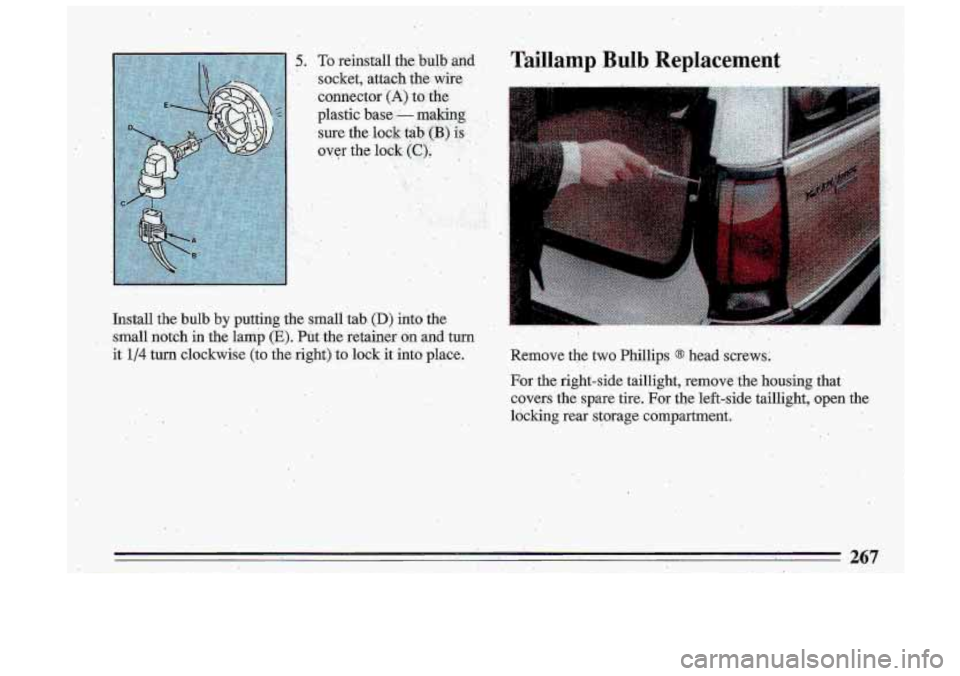
5. Bulb
I_ -. _I-
Replacement , . ..
. -.
j.! i I I. !
Install the bulb by putting the sriJall tab- (D) hto the J;: ~ I..' '
small notch in the lamb (E). PGt the 'retainer: on and. turn
. ..
it 1/4 tun clockwise (to the.right).'to lock it into place. Remove-the two Phillips @ head screws;
For .the right-side taillight, remove The housing that
covers the spare tire'. For the left-side taillight, open the
ldcking rear storage compartment.
267
Page 273 of 340

,I
Station wagons can carry more weight than regular
passenger cars:- You’ll find ,the heading-“Maximum
Loadingat
GVWR” on the Tire-Loading- Information
labei.
YQU can load your station wagon up to the limit
shown there, but only if
you’ take the following steps: ;
1.
2.
3.
-4.
.. ..
I
IT you swerloaa your somon wagon, you CQI
damage parts of the vehicle and/or affect
vehicle handling. Either of these could cau!
you
to 10s- --1trol of the vehicle and you c-~d
be injured
Newer carry rn ht than the
Certification label under “Gross Vehicle Weight
r ‘‘Gross Axle Weight Rating
..
Tires ..
We, don’t make tires. Your new vehicle comes with high
quality tires made by a leading tire,manufacturer. These
tires are
warranted.:by the tire manufacturers and their :
warranties are delivixed with every new Buick. :If your
spare ti& is a different brand than yo& road tires,. you
will have a tire warranty folder fi-om eaGh of these
manufacturers.
I
271
Page 275 of 340
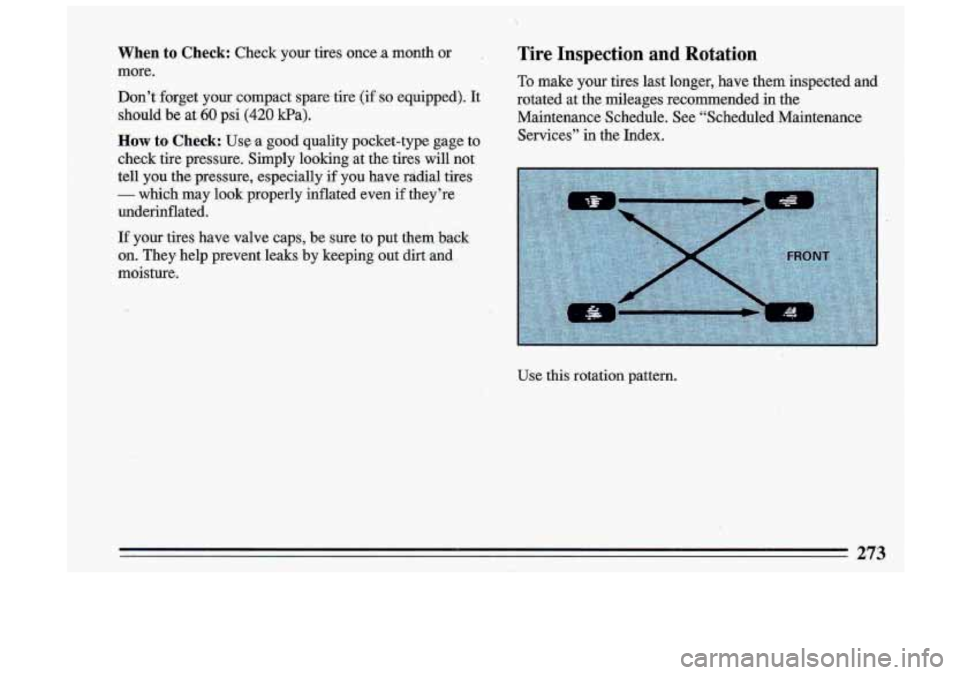
When to Check: Check your tires once .a month or
more.
Don’t forget
your compact spare-tire (if SO equipped). It
should be at 60 psi (420 Pa).
How to Check: Use a good quality pocket-type gage to
check tire pressure. Simply looking at the tires will not
tell you the pressure, especially if
you have radial tires
- which may look properly inflated even if they’re
underinflated.
If your tires have valve caps, be sure to put them back
.on. They help prevent leaks by keeping
out dirt and
moisture.
Tire Inspection and Rotation
To make your tires last longer, have them inspected and
rotated at the mileages recommended in the, Maintenance Schedule. See “Scheduled Maintenance Services”
in the Index.
Use this rotation pattern.
t
273
Page 277 of 340
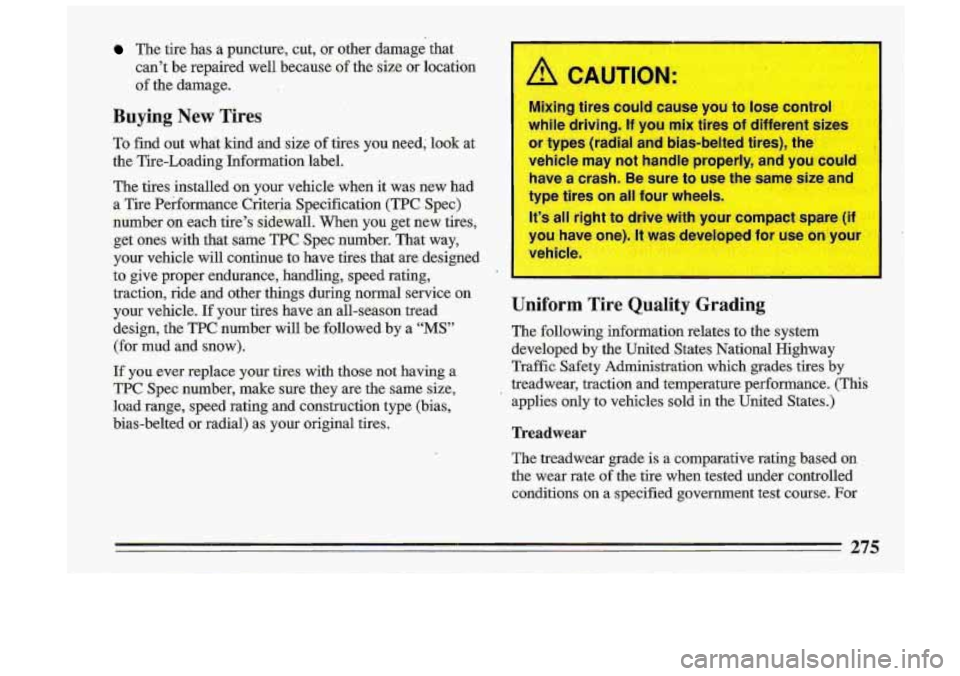
The tire has a puncture, cut, or other damage that
can’t be repaired well because of the size or location
of the damage.
Buying New Tires
.To find out what kind and size of tires you need; look at
the Tire-Loading Information label.
The tires installed on your vehicle when it was new had
a Tire Performance Criteria Specification
(TPC Spec)
-number on each tire’s sidewall. When you get new tires, get ones with that same TPC Spec number.
That way,
your vehicle will continue
to have tires that are designed
to give proper endurance, handling, speed rating,
traction, ride and other things during normal service on
your vehicle.
If your tires have an all-season tread
design, the
TPC nu-mber will be followed. by a “MS”
(for mad and snow).
If you ever replace your tires with those not having a
TPC Spec number, make sure .they are the same size,
load range, speed rating and construction type (bias,
bias-belted or radial) as your original tires.
‘t
A CAUTION:
Mixing tires could cause you to lose control
while driving. If you mix tires of different siz
or types (radial and bias-belted tires), the
vehicle may not handle properly, and you
cows
have a crash. Be sure to use the same size and
type tires
on all four wheels.
It’s all right to drive with your compact spare (if
you have one). It
was developed for use on your
I
I
‘ :le.
Uniform Tire Quality Grading
The following information relates to the system
developed by the United States National Highway
Traffic Safety Administration which grades tires
by
treadwear, traction and temperature performance. (This
applies only to vehicles sold
in the United States.)
Treadwear
The treadwear grade is a comparative rating based on
the wear rate of the tire when tested under controlled
conditions
on a specified govement test course. For
I